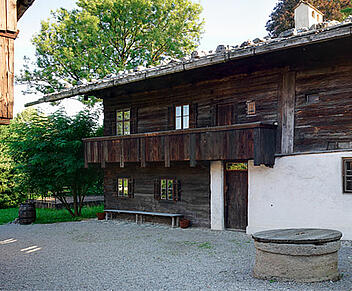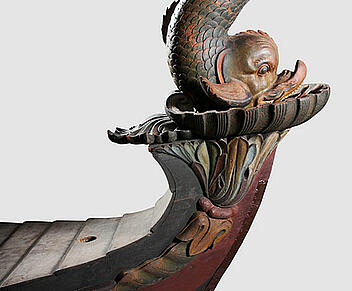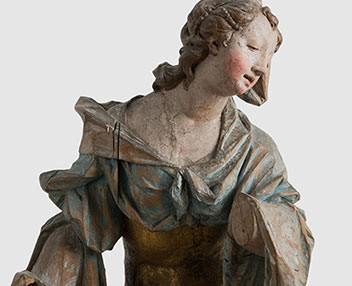
Ignaz Günther
Female Saint of Starnberg, 1755
Object type: Sculpture
Inventory number: L73/207
Acquired: 1914
Material: Lime wood, colored
Dimensions: 159.5cm × 75.5cm × 47cm (5'3" × 2'6" × 1'6")
On display: Yes
The Female Saint of Starnberg is probably the most famous work of art from the region around Lake Starnberg. This life-size carved sculpture in the style of South German Rococo was created by the famous sculptor Ignaz Günther in 1755, as indicated by the signature on the back: “F.J. Gindter.fecit 1755.” Günther, born in 1725, had his own workshop in Munich from 1754, and also built the high altar at St. Joseph’s Church in Starnberg.
The Female Saint of Starnberg belonged to the museum’s collection from the start. Nowadays, it’s displayed in the chapel attached to Lochmann House. It’s thought to have been originally positioned on the altar of the small Church of Saints Peter and Paul in Harkirchen near Berg as it was discovered on the nearby estate of the Klenze family.
This delicate, almost angelic figure exudes a unique charm. Her elegant face and the masterly execution of the folds of the robe are typical of Günther. Her slender body has a graceful posture with her right leg stretched forward and her left leg kneeling. Her substantial, flowing robe is held together by a golden bodice. Since both hands are missing, no symbols have been preserved, meaning for a long time the female figure couldn’t be identified.
However, when the saint was examined by the Bavarian Office for Heritage Conservation in 2015, an opening was revealed on the sculpture in which part of a cartwheel was probably attached. The figure is therefore now thought to represent Saint Catherine of Alexandria, who was revered as a martyr. Legend has it that when she was put to death on the wheel, the wheel was destroyed by an angel. Another sculpture of St. Catherine by Ignaz Günther on the Altar of St. Eligius in St. Peter’s Church in Munich bears a sword in her right hand. Who knows whether the Female Saint of Starnberg once also held a sword?












